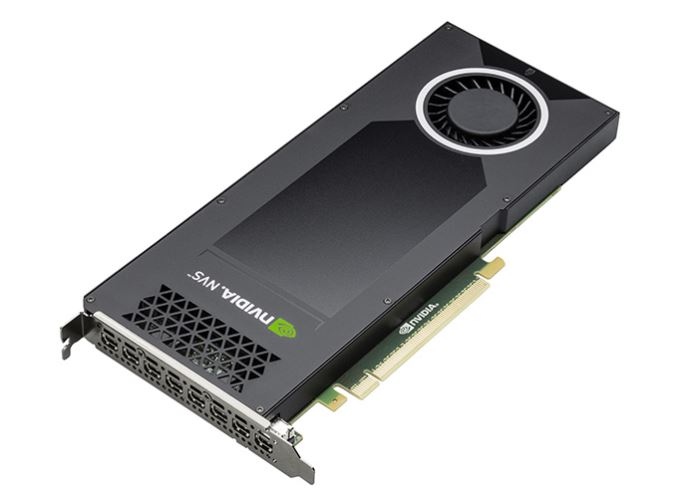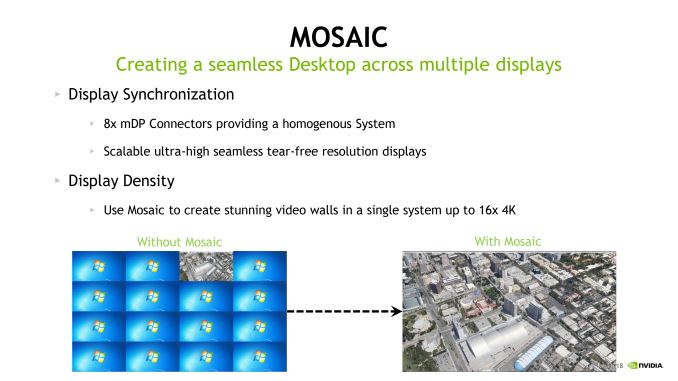NVIDIA Launches NVS 810 Digital Signage Video Card
by Daniel Williams on November 4, 2015 5:30 PM EST
Entry level multi-display workstations aren’t a market that gets anywhere near the amount of attention that many of us are used to seeing in other markets. Never the less it is a market that definitely needs something catering to its needs, be it large format signage, financial trading, or any other area where a large number of displays are needed but not a large amount of horsepower to push them.
To that end, today NVIDIA is launching a new entry into their venerable NVS multi-display lineup, the NVS 810. Seeing as this market segment doesn't see updates very often this is the first and possibly only Maxwell based card to be released in this sector. This card is based around a pair of GM107 GPUs on a single board, allowing NVIDIA to outfit the NVS 810 with 8 mini-DP 1.2 ports on a single-wide PCIe card.
For the NVS 810’s hardware, under the hood we are looking at a pair of partially enabled GM107 GPUs with 512 of 640 CUDA cores enabled, for a total of 1024 CUDA cores. This is paired up with 2GB of VRAM per GPU for a total of 4GB, and though NVIDIA doesn’t specify the memory type it’s safe to assume it’s DDR3. Otherwise NVIDIA is targeting a relatively low power profile here – just 68W total board power – with the lower board power helping with GPU density and makes stuffing the maximum of four of these cards into a single machine at once a much more civil affair.
| NVIDIA NVS 810 Specfications | ||
| NVS 810 | ||
| CUDA Cores | 2 x 512 (1024) | |
| Memory | 2 x 2GB (4GB) | |
| Display Connectors | 8x Mini DisplayPort (8x 4096x2160 @ 30Hz or 4x 4096x2160 @ 60Hz) |
|
| Max Configuration (Win10/Linux) |
4 Boards, 32 Displays | |
| Total Board Power | 68W | |
| Length | 9.5" | |
| Width | Single Wide (4.4") | |
| Cooling | Active | |
| MSRP | $650-$750 | |
Speaking of stuffing cards in a machine, while I imagine that real world implementations of this may be rare, where I notice that this solution gets immensely crazy is the sheer number of mDP ports on hand coupled with the ability to fit four in one machine. Coupled with NVIDIA’s Mosaic display stitching and synchronization software, it’s possible to use a pair of NVS 810s together to drive up to 16 4K displays as if they are one massive display. Regardless of the rarity of such an implementation the idea that one could build a micro-ATX computer that could drive what’s functionally a 137MP display is a very impressive thought indeed.
Wrapping things up, NVIDIA tells us that the NVS 810 is expected to have a street price in the $650-$750 range. Overall the company is pitching the NVS 810 as a high density, low total cost solution to situations requiring a large number of high pixel count displays. As a result NVIDIA is chasing a very specific market with the board, but for those with such needs the NVS 810 brings quite a bit to the table.











38 Comments
View All Comments
2old4this - Thursday, November 5, 2015 - link
YupSee http://www.displayport.org/cables/driving-multiple...
And a Nvidia driver limit of 32 max.
Laststop311 - Thursday, November 5, 2015 - link
the price is a major rip off. A partially enabled gm107 die is worth like 75 bucks 100 max so at max this card should be 200 dollars. They are really milking the hell outta this card.2old4this - Friday, November 6, 2015 - link
Well,- in this market segment, Nvidia is a monopolist. Like Intel (see Xeon pricing).
- Card is for OEM. Not for consumers. Here play product aspects (built- & driver-quality, low-noise) and commercial aspects (supply chain, change management, LCM, pre-qual samples, EOL, LTB).
- Cost wise NVS810 should equal 4x NVS310 or 2x NVS510. And its way above. But then, can you place all those cards in your workstation/server?
Eidigean - Saturday, November 7, 2015 - link
With this card having two GPUs, there is also a PEX 8747 on board, which has been extortionately expensive since PLX was purchased by Avago. Add another $100-$150 just for that.varg14 - Friday, November 6, 2015 - link
I would rather have 2 more 34" 3440 x 1440 21/9 monitors and 3 EVGA GTX 980ti Classified cards in tri SLI if we are talking about a true honest to goodness immersive surround gaming experience. Heck I would even take 2 27" 2560 x 1440 monitors to go with my 34" LG 34UM95 I am currently using that does a great job of immersing you in whatever game your playing. Since the 34" 21/9 1440p monitor is the center panel and is very wide I think 2 more 21/9's would be overkill since I do not want to have to crane my neck left and right too much. Just the one 21/9 monitor I am using allows me to scan the horizon in Warthunder Ground forces with my eyes instead of having to mouse left or right as much as with a standard 19/9 monitor would make me have to.21/9 is here to stay and is about the best thing to come along since the whole eyefinity and NV surround deals that have been out for ages. Too bad they do not make a 32/9 1440p monitor which would be 5120 x 1440 and would be totally awesome, it could even be made on the same assembly line as the 1440p 16/9 panels just do not cut them to make 27" panels.
Looks like the real VR tech is going to use this resolution thanks to Star VR
StarVR was born from Starbreeze’s purchase of InfinitEye, which previously discussed the potential for ridiculously high resolution set-ups in VR. At that time, it was conceptual more than actual, but the actual realization is now what the guys at Starbreeze claim to have made. Their StarVR headset is an HMD that is capable of a 5,120 x 1,440 pixel resolution and an even more ridiculous 210-degree viewing angle.
Read more: http://www.digitaltrends.com/computing/starvr-vr-h...
Follow us: @digitaltrends on Twitter | digitaltrendsftw on Facebook
ElBerryKM13 - Friday, November 13, 2015 - link
Why is nvidia doing a paper launch on this? I have yet to find a retailer that have any stock. This is the perfect solution to my setup and it couldn't have arrived at a better time for me.Kutark - Sunday, November 15, 2015 - link
This card is in NO way intended for gaming in ANY capacity. I don't understand why so many comments in this thread are in regards to gaming.jsellin - Sunday, May 1, 2016 - link
@KutarkI would get ONE of the NVS810s and then have another Video card to the rendering for it.
I ran 9 monitors using 3 Nvidia 210s + a radeon 6970.
The primary display was set as one of the Monitors connected to the 6970.
I had 8 Everquest windows @ 1080p each with the 6970 rendering.
No lag at all.